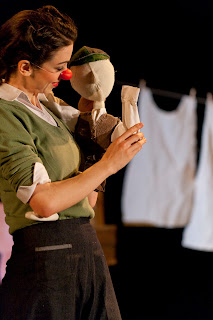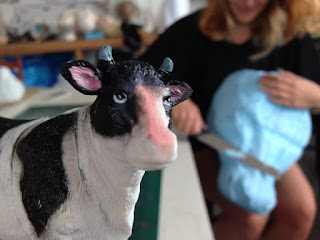Ed Elbourne is a freelance lighting designer and currently on tour with Blind Summit as Technical Manager for The Table at Spoleto Festival USA, 2017.
 |
Ed & Mark in technical rehearsals
for The Table |
How did you start working with Blind Summit?
Steph (Executive Producer) asked me to cover a few shows of The Table which was touring in Erfurt. I think that's where Martin Luther was from? It was when Germany beat Brazil in the World Cup. The Germans were quite excitable as a result!
How has The Table changed from when you last worked on it?
The show is actually very different. Which is important because it still feels like a fresh, improvised stand up. So structurally and metaphorically, it’s a different show to the one I lit 3 years ago.
Are there particular considerations to be made when lighting puppets?
I recently went to a conference called ‘Showlight’ where David Duffy (Little Angel) gave an excellent talk about the technicalities of lighting the puppet and not the puppeteer. This is imperative where the puppetry is taking an audience into a visual illusion - to maintain the theatre magic. It's very different with the Table, though - there’s no concealing that there are 3 operators of the puppet! We aren’t trying to hide the puppeteers, but we’re trying to light the puppet itself in a certain way, for effect.
What are the key elements of the lighting design for The Table?
 |
Waiting for Stanley
Lighting by Ed Elbourne |
Defining space. Because it’s such a focused piece of theatre, we need to define the space so that the audience don’t feel distant and stay engaged, and that the puppet owns the space. And then getting the angles right on Moses' face. He's a brilliant puppet, the slightest change in angle of light on his face gives him a whole new expression.
What about other shows you’ve lit with puppets?
I've lit a few where a puppet is included amongst non-puppet performers. It can be difficult because the puppet moves around a much larger area than a puppet-only show, and you just can't be as precise. You fall back on larger washes of asymmetric side light and top light to sculpt the face and give a puppet expressions. The human brain is so good at ‘filling in’ faces on things that aren’t faces - we see faces in clouds, for example. So creating contrasts of light across a puppet's face with shadows and colours and audiences helps project expressions onto them.
What’s your proudest moment?
I'm very proud of The Table, because the audience love it so much. And ultimately that’s why we do what we do. Isn’t it?





















